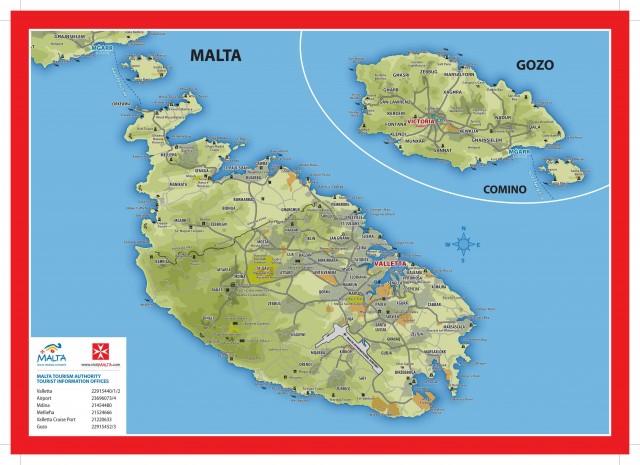Malta
Area 122 square mi (316 square km)
Population 427,400 2014
Capital Valletta
Highest Point 830 ft (253 m)
Lowest Point 0 m
GDP $9.643 billion 2013
Primary Natural Resources globigerina limestone, petroleum, tourism.
THE COUNTRY OF MALTA, which calls itself the Repubblika Ta' Malta, is an archipelago made up of five islands: Malta, Gozo, Comino, Cominotto, and Filfla, as well as two small islets known together as St. Paul's Islands. Only the first three, Malta, Gozo, and Comino, are inhabited. Malta is near the center of the MEDITERRANEAN SEA, 58 mi (93 km) south of Sicily and 179 mi (228 km) north of LIBYA, although its latitude is south of Tunis. It is about midway between GIBRALTAR and Tel Aviv, ISRAEL, at the opposite end of the Mediterranean. The main island of Malta is farthest east, and, in parts, is densely populated. On its southeast is the Grand Harbor, which made it an attractive port for the ancient Phoenicians, Carthiginians, and Romans for centuries. Today it is considered an underdeveloped area of fishing villages.

None of the islands have permanent lakes or streams, and 70 percent of the water used on Malta comes from desalinization plants. Malta has a high population density, particularly in the areas near its largest city, Birkirkara, and its capital, Valletta, both located on the northeast section of Malta Island. Malta's tourism industry is fueled by its beaches and mild climate and by its historical sites. Tourism accounts for one-quarter of Malta's gross domestic product, and the islands host over 1 million visitors per year. Many come to enjoy 85 mi (137 km) of beaches and year-round sunshine; Malta's average monthly temperature ranges from 54 to 88 degrees F (12 to 31 degrees C). Diving, windsurfing, sailing, and other sports attract visitors year round.
Megaliths and religious temples from the 4th millennium B.C.E, predating the rise of Sumer and EGYPT, have been excavated on Malta and Gozo. Roman temples and villages, walled medieval towns, domed Renaissance churches, and forts built by knights of the Crusades are popular tourist sites. Phoenicia and Carthage maintained ports on Malta for trade until the islands were subsumed into the Roman Empire in 218 b.c.e., after the Second Punic War. In Biblical times, St. Paul was shipwrecked in a bay that still bears his name. From the 6th through the 9th century C.E., Malta was part of the Byzantine Empire, then it passed into Arab hands. In 1090, Normans drove out the Arabs and made Malta an appendage of Sicily. As such, it passed through the ownership of several European kingdoms until 1530. At that point, Charles V of the Holy Roman Empire ceded Malta to the Knights Hospitalers of St. John of Jerusalem, who are sometimes known as the Knights of Malta. Many of the spectacular ruins of Malta were built by this group, which successfully defended the island against Suleiman the Magnificent and the Turkish Empire. Napoleon took over Malta in 1798, and the BRITISH EMPIRE was in control by 1814. The scene of much fighting in World War II, Malta gained independence in 1964.
Malta today is a republic, with an elected president and unicameral legislature and an appointed prime minister. It officially joined the EUROPEAN UNION in 2004. The country is 98 percent Roman Catholic, and the official languages spoken are English and Maltese, a language that developed from North African Arabic and Sicilian Italian.